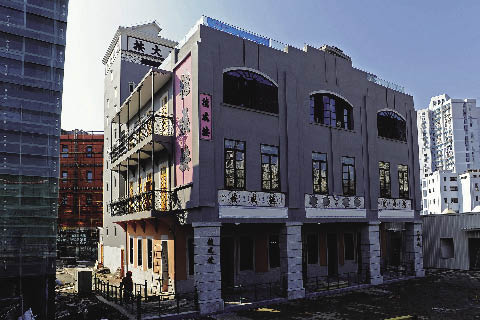|
Rhone-Alps of France has created an energy-saving lighting system by using special building materials to adjust interior temperature and light. And Liverpool of England has worked with corporations and commercial organizations in protecting and utilizing architectural heritage.
Part of the 80 models are operating life-size cases and the remaining take the form of exhibitions. Half of them are from the developed cities of Europe and 10 are from China.
Solutions to Common Urban Problems
 |
|
The century-old “Tak Seng On Pawnshop” of Macao reproduced on a 1:1 scale at the UBPA. Photos by China Foto Press |
"One hundred and fifty years ago, only 6 percent of the world's population lived in cities; today that figure has reached 50 percent. Shanghai 2010 ponders the future of the city both from an historic angle and these sorts of moving targets, and in so doing tries to reach a worldwide consensus on what the future will look like," says Wu Zhiqiang, chief planner of the Shanghai World Expo.
The city, as a form of compact living, marks the maturity and civilization of humankind. But the rapid ballooning of cities willy-nilly has brought about a series of social, cultural and environmental plagues – overpopulation, pollution, damage and loss of cultural heritage, and more acute urban-rural disparity. Can we find solutions to these common problems that cities face today, through the UBPA's showcases?
The "Cycle City" of Odense, the third largest city of Denmark, may shed some light on the answer. Back in the 1970s, when many cities were replacing bicycles with private cars as a means of communication, the Odense municipal government began to build cycle lanes, which expanded into a 550-km network.
The city has developed concomitant supporting policies and facilities that encourage cycling – interactive websites that provide guides to cycling routes, smooth lanes that guarantee cycling safety, passage precedence for cyclists at intersections, drinking water and tire inflating facilities along cycling routes, and safe and comfortable parking lots.
These measures have changed remarkably the proportion of cyclists to the number of private cars and the results are more than encouraging – a reduction of waste gas discharge and traffic accidents that involve cyclists, and measurable improvement in public health and urban environment.
The "zero-carbon" pavilion of London is based on the Beddington Zero Energy Development (BedZED) project in southern London. It showcases the incredible results of BedZED's energy-saving practices. The pavilion reduces carbon dioxide emissions by minimizing the usage of fossil fuels, such as coal, petroleum and natural gas, and maximizing the self-sufficient recycling operation of solar, wind, biological and geothermal powers for energy supply. For example, discarded disposable tableware and other organic waste generate electric and thermal energy in the process of degradation, and their residues can be used as bio-fertilizer.
The 80 cases are divided into four themed sections: Livable City, Sustainable Urbanization, Protection and Utilization of Historical Heritage, and Technological Innovation in the Built Environment. In building the city of tomorrow they embody responsibility as well as innovation.
Tree Houses and Air Trees
Many of the best urban practices were isolated real-life experiments modified and rolled out.
| 